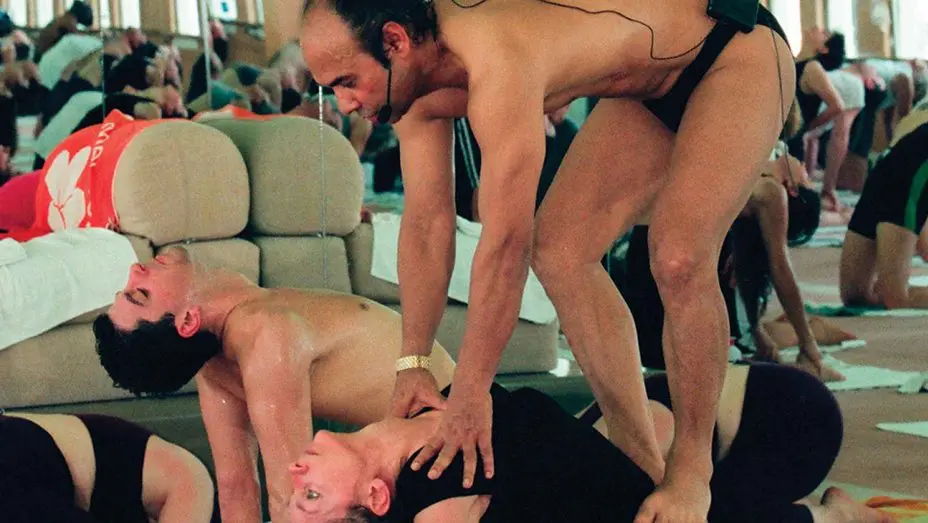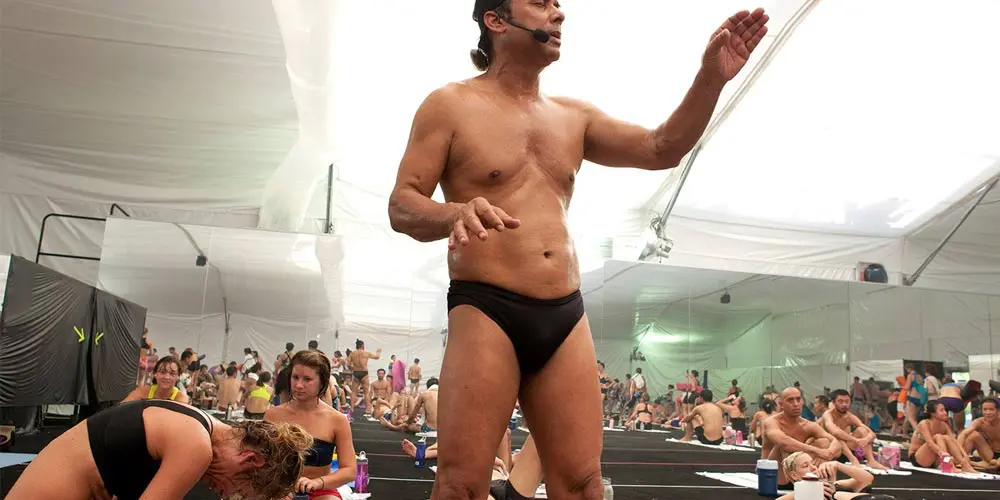Summary
Eva Orner’s damning Netflix documentary paints a hideous portrait of Bikram Choudhury, a despicable and elusive abuser whose cult continues to flourish.
An old and well-known fable holds that the way to cook a frog is slowly. If one is tossed into a pan of boiling water, it’ll leap out. But if one is lured into tepid water that is gradually heated, it won’t notice, and will be cooked to death. This isn’t true, but it’s what came to my mind while watching Eva Orner’s damning new documentary Bikram: Yogi, Guru, Predator (Netflix), about the despicable abuser Bikram Choudhury, the form of heated yoga he developed, promoted, and extensively profited from, and the unwitting victims – most of them women – that he gradually brought to the boil.
To put matters simply: Choudhury, in his signature outfit of tiny black Speedos, his receding hair bound in a tight, high ponytail, looks exactly like the rapist that he is – or is at least credibly accused of being, since he fled the United States, where he made his fortune, and refused to part with the portion of it that was to be awarded in damages to his former legal advisor and one of his many victims, Minakshi “Micki” Jafa-Bodden, before he could be brought to any kind of justice. He continues his maniacal campaign abroad, still shielded by his complicit ex-wife Rajashree; both refused to participate in Orner’s film, as well they might.
Bikram: Yogi, Guru, Predator traces both the origins of Bikram’s hot yoga practises – 26 positions, though perhaps not the kind he’d most like, performed in a room heated to over 100 degrees Fahrenheit – and his delusional, narcissistic self-mythologizing, which came with him from Kolkata, where he was born in 1944, to the United States, where he arrived in the 70s, apparently at the request of Richard Nixon. His bizarre claims include having taught yoga to NASA astronauts and invented the disco ball; difficult to believe at the best of times, but especially since evidence uncovered by both ESPN’s “30 for 30” podcast and Jerome Armstrong’s book Calcutta Yoga have proven even Bikram’s earliest claims of training and accolades to be fabrications.

But what is undeniable is the explosive popularity Bikram yoga enjoyed and the cult of personality that formed around Choudhury, who became through his own efforts and the effectiveness of his techniques a kind of eccentric secular leader. Various endorsements from celebrity clientele didn’t hurt. Most of his fortune – which reportedly climbed to $75 million and included a fleet of luxury cars – was amassed through exclusive teacher-training sessions, held twice yearly and for nine weeks at a time in isolated retreats, and costing $10,000. Graduates of these courses could open their own Bikram schools, but only with Choudhury’s express permission, meaning he kept a tyrannical stranglehold on the hot yoga industry – at one point he tried to sue Raquel Welch for stealing his techniques in an exercise book, which New York studio owner Greg Gumucio told ABC News was as legally ludicrous as Arnold Schwarzenegger trying to copyright bench presses and bicep curls.
But Choudhury’s control was nonetheless absolute, and to oppose him, either in business or by exposing his predatory and flagrantly bigoted behaviour, was to risk social and financial ruin. Too much power was concentrated in his hands and those of his devotees, many of whom still operate Bikram studios in the US even today, in light of the allegations brought against him by the aforementioned Jafa-Bodden, and Larissa Anderson and Sarah Baughn, who came forward in 2014 and account for two of the strongest voices in Bikram: Yogi, Guru, Predator.
Orner’s film is compelling in its assemblage of decades of archive footage, court depositions and first-person testimony; the portrait it paints is essentially that of a madman whose grubby hands never left the thermostat of the sealed environment he created for his own unacceptable abuses. Brave women like Jafa-Bodden, Anderson and Baughn proved that old fable about frogs, like many or perhaps all of Bikram’s claims about his life and work, to be a falsehood. They leapt free of the pan before they were boiled, and gave no compliments to the chef. That he continues to turn up the heat abroad is a grave injustice that perhaps a film like Bikram: Yogi, Guru, Predator might help in some way to correct.




